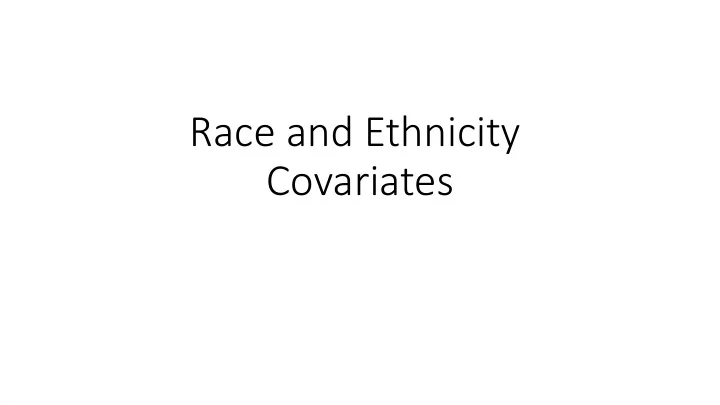

Race and Ethnicity Covariates
Race and ethnicity are a good illustratjon of the trade-ofgs between clinical and research data • Race and ethnicity data in prospectjvely collected research datasets are usually reliable and valid • Questjon: What kind of validity is this? • BUT, the racial and ethnic distributjons in research datasets ofuen aren’t representatjve of broader populatjons of interest • In other words, fjndings from these prospectjvely collected data sets may have limited ________ with respect to race and ethnicity?
Let’s take a look at the race data from SHHS • Group 1: Look at published literature or census data to get some basic info on the populatjon- level proportjons of black, white, and “other” (since these are the categories in SHHS) • Group 2: Using the data explorer, fjnd the proportjons of black, white, and other in the SHHS dataset. How did you fjnd this informatjon? • Group 3: How ofuen are race data missing in the SHHS dataset, and how did you fjnd this info? If you have tjme, are race data missing completely at random, or is there a relatjonship between missingness of race and outcome (any_cvd) or one of the otherprimary covariates? As a class, compare these distributjons. Think about the following: • Are the distributjons relatjvely similar, or difgerent in a meaningful way? • If they are difgerent, what could be the possible repercussions in understanding results from SHHS? • What could be possible reasons for any difgerences you observe?
What about race and ethnicity in EHR data? • Likely to be more representatjve of the actual populatjon, with some limitatjons • Questjon: How might you expect the demographics of a hospital-based sample to difger from the broader populatjon with respect to race and ethnicity? • But what about the quality of the race and ethnicity data?
Quality of EHR race and ethnicity data? 70.9% of black patjents are correctly identjfjed as black in the EHR. Therefore, 29.1% of black patjents are not identjfjed as black. 79.3 % of patjents who prefer Spanish are identjfjed as preferring Spanish in the EHR. Therefore, 20.7 % of patjents who prefer Spanish do not have this preference in the EHR. If a patjent’s preferred language is listed as Spanish in the EHR, there’s a 63.9% chance that they actually prefer Spanish. Therefore, if a patjent is identjfjed as preferring Spanish, there’s a 36.1% chance they prefer a difgerent language. Klinger, E.V., Carlini, S.V., Gonzalez, I. et al. J GEN INTERN MED (2015) 30: 719. https://doi.org/10.1007/s11606-014-3102-8
Discussion questjons about quality of EHR race and ethnicity data • Based on your knowledge of how race and ethnicity are recorded in the EHR, what possible reasons could you think of for this disagreement? • Would you expect to see similar rates of agreement and disagreement across difgerent instjtutjons? • How much do you think this matuers in reuse scenarios? (Also worth considering impact at the point of care) • Missing and incorrect race and ethnicity data could potentjally impact internal validity. What does this mean for external validity?
Recommend
More recommend